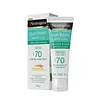What's inside
What's inside
 Key Ingredients
Key Ingredients

 Benefits
Benefits

 Concerns
Concerns

 Ingredients Side-by-side
Ingredients Side-by-side

Water
Skin ConditioningHomosalate
Skin ConditioningSilica
AbrasiveOctocrylene
UV AbsorberEthylhexyl Salicylate
UV AbsorberButyl Methoxydibenzoylmethane
UV AbsorberAluminum Starch Octenylsuccinate
AbsorbentEthylhexyl Triazone
UV AbsorberMethylene Bis-Benzotriazolyl Tetramethylbutylphenol
UV FilterTriacontanyl Pvp
HumectantDimethicone
EmollientCaprylyl Methicone
Skin ConditioningSodium Potassium Aluminum Silicate
Glyceryl Stearate
EmollientIsononyl Isononanoate
EmollientNiacinamide
SmoothingPEG-100 Stearate
Potassium Cetyl Phosphate
EmulsifyingStearyl Alcohol
EmollientAlcohol
AntimicrobialPhenoxyethanol
PreservativeHydroxyacetophenone
AntioxidantBis-Ethylhexyloxyphenol Methoxyphenyl Triazine
Skin ConditioningTitanium Dioxide
Cosmetic ColorantDimethicone Crosspolymer
Emulsion StabilisingParfum
MaskingSodium Ascorbyl Phosphate
AntioxidantAcrylates/C10-30 Alkyl Acrylate Crosspolymer
Emulsion StabilisingDisodium EDTA
Tocopheryl Acetate
AntioxidantChrysanthemum Parthenium Flower/Leaf/Stem Juice
AntioxidantAmyl Cinnamal
PerfumingBenzyl Salicylate
PerfumingWater, Homosalate, Silica, Octocrylene, Ethylhexyl Salicylate, Butyl Methoxydibenzoylmethane, Aluminum Starch Octenylsuccinate, Ethylhexyl Triazone, Methylene Bis-Benzotriazolyl Tetramethylbutylphenol, Triacontanyl Pvp, Dimethicone, Caprylyl Methicone, Sodium Potassium Aluminum Silicate, Glyceryl Stearate, Isononyl Isononanoate, Niacinamide, PEG-100 Stearate, Potassium Cetyl Phosphate, Stearyl Alcohol, Alcohol, Phenoxyethanol, Hydroxyacetophenone, Bis-Ethylhexyloxyphenol Methoxyphenyl Triazine, Titanium Dioxide, Dimethicone Crosspolymer, Parfum, Sodium Ascorbyl Phosphate, Acrylates/C10-30 Alkyl Acrylate Crosspolymer, Disodium EDTA, Tocopheryl Acetate, Chrysanthemum Parthenium Flower/Leaf/Stem Juice, Amyl Cinnamal, Benzyl Salicylate
Water
Skin ConditioningPropanediol
SolventCyclopentasiloxane
EmollientBiosaccharide Gum-1
HumectantCydonia Oblonga Leaf Extract
Skin ConditioningCaprylyl Methicone
Skin ConditioningSilica
AbrasiveSaccharide Isomerate
HumectantSuccinoglycan
Skin ConditioningDimethicone Crosspolymer
Emulsion StabilisingEthylhexylglycerin
Skin ConditioningHydrogenated Polydecene
EmollientSodium Acrylates Copolymer
Citric Acid
BufferingPhenoxyethanol
PreservativePPG-1 Trideceth-6
Skin ConditioningParfum
MaskingWater, Propanediol, Cyclopentasiloxane, Biosaccharide Gum-1, Cydonia Oblonga Leaf Extract, Caprylyl Methicone, Silica, Saccharide Isomerate, Succinoglycan, Dimethicone Crosspolymer, Ethylhexylglycerin, Hydrogenated Polydecene, Sodium Acrylates Copolymer, Citric Acid, Phenoxyethanol, PPG-1 Trideceth-6, Parfum
 Reviews
Reviews

Ingredients Explained
These ingredients are found in both products.
Ingredients higher up in an ingredient list are typically present in a larger amount.
Caprylyl Methicone is a type of silicone.
It helps soften and soothe the skin by creating a thin film on top. This film helps trap moisture, keeping your skin hydrated.
Dimethicone Crosspolymer is a silicone created by modifying dimethicone with hydrocarbon side chains. Due to its large size, it does not penetrate skin. It is considered non-occlusive.
Dimethicone Crosspolymer is used to stabilize and thicken products. It also helps give products a silky feel.
Parfum is a catch-all term for an ingredient or more that is used to give a scent to products.
Also called "fragrance", this ingredient can be a blend of hundreds of chemicals or plant oils. This means every product with "fragrance" or "parfum" in the ingredients list is a different mixture.
For instance, Habanolide is a proprietary trade name for a specific aroma chemical. When used as a fragrance ingredient in cosmetics, most aroma chemicals fall under the broad labeling category of “FRAGRANCE” or “PARFUM” according to EU and US regulations.
The term 'parfum' or 'fragrance' is not regulated in many countries. In many cases, it is up to the brand to define this term.
For instance, many brands choose to label themselves as "fragrance-free" because they are not using synthetic fragrances. However, their products may still contain ingredients such as essential oils that are considered a fragrance by INCI standards.
One example is Calendula flower extract. Calendula is an essential oil that still imparts a scent or 'fragrance'.
Depending on the blend, the ingredients in the mixture can cause allergies and sensitivities on the skin. Some ingredients that are known EU allergens include linalool and citronellol.
Parfum can also be used to mask or cover an unpleasant scent.
The bottom line is: not all fragrances/parfum/ingredients are created equally. If you are worried about fragrances, we recommend taking a closer look at an ingredient. And of course, we always recommend speaking with a professional.
Learn more about ParfumPhenoxyethanol is a preservative that has germicide, antimicrobial, and aromatic properties. Studies show that phenoxyethanol can prevent microbial growth. By itself, it has a scent that is similar to that of a rose.
It's often used in formulations along with Caprylyl Glycol to preserve the shelf life of products.
Silica, also known as silicon dioxide, is a naturally occurring mineral. It is used as a fine, spherical, and porous powder in cosmetics.
Though it has exfoliant properties, the function of silica varies depending on the product.
The unique structure of silica enhances the spreadability and adds smoothness, making it a great texture enhancer.
It is also used as an active carrier, emulsifier, and mattifier due to its ability to absorb excess oil.
In some products, tiny microneedles called spicules are made from silica or hydrolyzed sponge. When you rub them in, they lightly polish away dead skin layers and enhance the penetration of active ingredients.
Learn more about SilicaWater. It's the most common cosmetic ingredient of all. You'll usually see it at the top of ingredient lists, meaning that it makes up the largest part of the product.
So why is it so popular? Water most often acts as a solvent - this means that it helps dissolve other ingredients into the formulation.
You'll also recognize water as that liquid we all need to stay alive. If you see this, drink a glass of water. Stay hydrated!
Learn more about Water